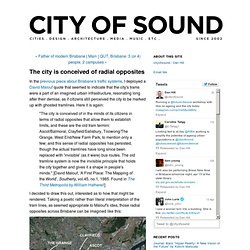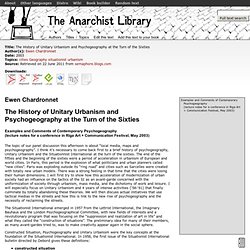

Jste Tady. The city is conceived of radial opposites. In the previous piece about Brisbane's traffic systems, I deployed a David Malouf quote that seemed to indicate that the city's trams were a part of an imagined urban infrastructure, resonating long after their demise, as if citizens still perceived the city to be marked up with ghosted tramlines.

Here it is again: "The city is conceived of in the minds of its citizens in terms of radial opposites that allow them to establish limits, and these are the old tram termini: Ascot/Balmoral, Clayfield/Salisbury, Toowong/The Grange, West End/New Farm Park, to mention only a few; and this sense of radial opposites has persisted, though the actual tramlines have long since been replaced with 'invisible' (as it were) bus routes. The old tramline system is now the invisible principle that holds the city together and gives it a shape in people's minds. " [David Malouf, 'A First Place: The Mapping of the World', Southerly, vol.45, no.1, 1985.
Found in The Third Metropolis by William Hatherell] Rewiriting Our Mental Image of the City. Collectivism after modernism: the art of social imagination after 1945 - Blake Stimson, Gregory Sholette. “Don’t start an art collective until you read this book.” —Guerrilla Girls “Ever since Web 2.0 with its wikis, blogs and social networks the art of collaboration is back on the agenda. Collectivism after Modernism convincingly proves that art collectives did not stop after the proclaimed death of the historical avant-gardes. Like never before technology reinvents the social and artists claim the steering wheel!”
—Geert Lovink, Institute of Network Cultures, Amsterdam “This examination of the succession of post-war avant-gardes and collectives is new, important, and engaged.” — Stephen F. “Collectivism after Modernism crucially helps us understand what artists and others can do in mushy, stinky times like ours. Spanning the globe from Europe, Japan, and the United States to Africa, Cuba, and Mexico, Collectivism after Modernism explores the ways in which collectives function within cultural norms, social conventions, and corporate or state-sanctioned art. The History of Unitary Urbanism and Psychogeography at the Turn of the Sixties by Ewen Chardronnet. Examples and Comments of Contemporary Psychogeography (lecture notes for a conference in Riga Art + Communication Festival, May 2003) The topic of our panel discussion this afternoon is about “local media, maps and psychogeography”.

I think it’s necessary to come back first to a brief history of psychogeography, Unitary Urbanism and the Situationnist International at the turn of the sixties. The end of the fifties and the beginning of the sixties were a period of acceleration in urbanism of European and world cities. In Paris, this period is the explosion of what politicians and urban planners called “new cities”. Paris was exploding outside its “ring road” and cities such as Sarcelles were created with totally new urban models. Occupy as psychogeographic urbanism [draft 3] [Draft 5 is much longer and edited in many places, to make it a bit easier: # mostly unchanged, # changed, # new paragraph.]
![Occupy as psychogeographic urbanism [draft 3]](http://cdn.pearltrees.com/s/pic/th/psychogeographic-21812961)
“As we gather together in solidarity to express a feeling of mass injustice, we must not lose sight of what brought us together. We write so that all people who feel wronged by the corporate forces of the world can know that we are your allies.” - Declaration of the Occupation of New York City [1] “It is like a little village. They have got a food tent, a welfare tent, a first aid tent, an information tent, a library tent and a university tent where they have their daily meetings. It is very well organised… They have organised there own portaloos but there is still a problem with street urination… The rainwater gullies have been blocked up with food waste.” – Assistant director of Street Scene on OccupyLSX [2] “At night, with such a big crowd in it, the space had started to redefine itself a bit, and more by ambience than function.
[December 2011 – March 2012] [3]